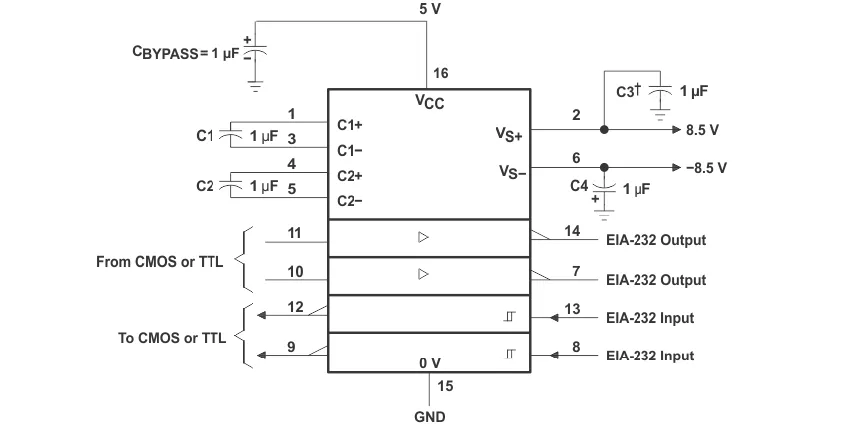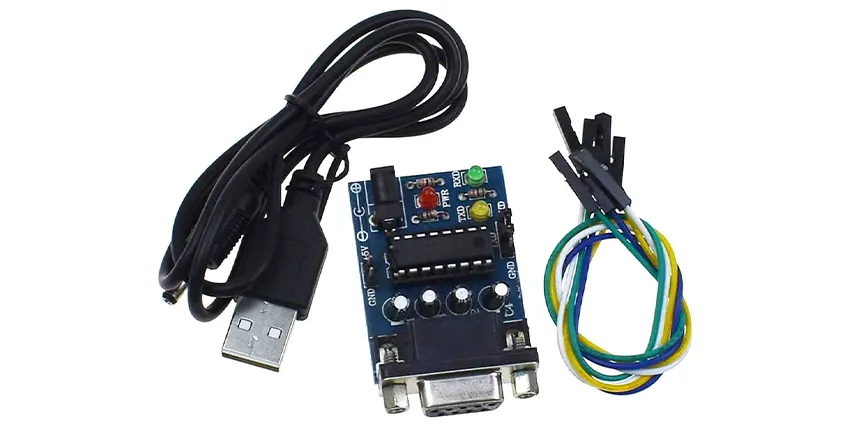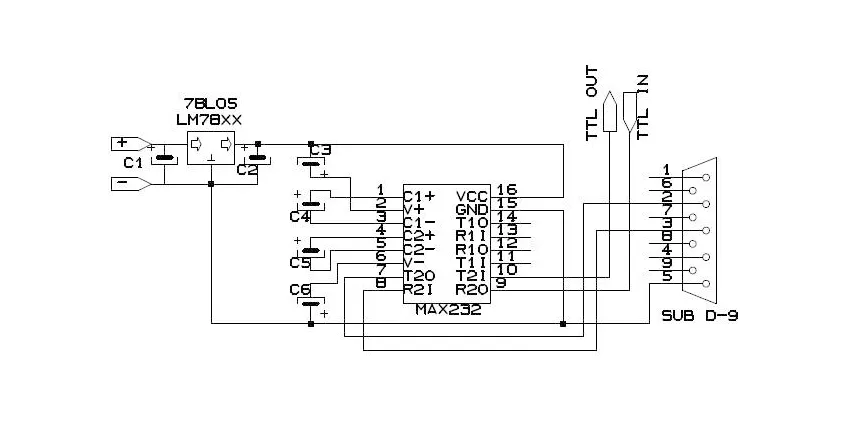The MAX232 IC is an essential component in the field of electronics, specifically for interfacing between microcontrollers and serial communication devices. Developed by Maxim Integrated, the MAX232 IC is a dual driver/receiver that includes a capacitive voltage generator to supply EIA-232 voltage levels from a single 5V supply.
This article will delve deep into the details of the MAX232 IC, its datasheet, usage, and various applications, providing a comprehensive understanding of its significance in modern electronic circuits.
Key Features of MAX232 IC

The MAX232 IC is widely used for converting signals from an RS-232 serial port to signals suitable for use in TTL-compatible digital logic circuits. This IC has become a standard for RS-232 serial communication, offering an efficient solution for voltage level conversion.
- Dual Driver/Receiver: The MAX232 IC can drive two receivers and accept two drivers.
- Voltage Levels: It converts RS-232 voltage levels to TTL levels and vice versa.
- Single Supply Operation: It operates on a single +5V power supply, making it convenient for most digital systems.
- Internal Charge Pump: The charge pump generates the necessary voltage levels for RS-232 communication, eliminating the need for dual power supplies.
- High Baud Rate: Supports baud rates up to 120 kbps, suitable for most serial communication requirements.
How Max232 Works?
The MAX232 is an integrated circuit that converts signals between RS-232 serial ports and TTL (Transistor-Transistor Logic) compatible logic levels.
It includes both drivers and receivers: drivers convert TTL logic levels (0V for low and 5V for high) to RS-232 levels (typically +3V to +15V for low and -3V to -15V for high), while receivers convert RS-232 levels back to TTL levels. The MAX232 uses an internal charge pump and external capacitors to generate the necessary voltage levels from a single 5V supply.
This allows for seamless communication between devices that use different voltage standards, such as computers and microcontrollers.
Detailed Analysis of the MAX232 Datasheet
MAX232 PDF Documentation
For detailed specifications, design guidelines, and application notes, the MAX232 PDF documentation is an invaluable resource. It provides comprehensive information, including:
- Pin Descriptions: Detailed explanation of each pin’s function.
- Typical Operating Characteristics: Graphs and tables showing performance metrics.
- Application Information: Examples and diagrams for integrating the MAX232 IC into different circuits.
- Absolute Maximum Ratings: Limits to ensure safe operation of the IC.
Understanding the MAX232 datasheet is crucial for leveraging its full potential in electronic designs. The datasheet max232 provides all the necessary specifications, including electrical characteristics, pin configurations, and typical application circuits. Here’s a breakdown of the key sections of the datasheet:
Electrical Characteristics
- Supply Voltage (Vcc): The operating voltage range is typically 4.5V to 5.5V.
- Current Consumption: It typically consumes 8mA under no-load conditions.
- Logic Levels: The input and output logic levels are compatible with TTL/CMOS.
Pin Configuration
The MAX232 chip comes in a 16-pin dual in-line package (DIP) or small-outline package (SOIC). Here’s a brief overview of its pinout:
- T1IN, T2IN: Transmitter inputs.
- R1OUT, R2OUT: Receiver outputs.
- T1OUT, T2OUT: Transmitter outputs.
- R1IN, R2IN: Receiver inputs.
- C1+, C1-, C2+, C2-: External capacitor connections for the charge pump.
- Vcc: Power supply pin.
- GND: Ground pin.
- V+ and V-: Generated voltages for RS-232 signal levels.
Use of MAX232 IC in Electronic Circuits

The use of MAX232 IC is prevalent in many electronic applications, especially where serial communication is required. Below are some common use cases:
Microcontroller Communication
One of the primary applications of the MAX232 IC is to facilitate communication between a microcontroller and a PC or other serial devices. Microcontrollers typically operate at TTL voltage levels (0-5V), while RS-232 standards use different voltage levels. The MAX232 IC bridges this gap by converting TTL signals to RS-232 levels and vice versa.
Embedded Systems
In embedded systems, the MAX232 chip is crucial for serial communication with peripheral devices like modems, GPS modules, and other sensors that use RS-232 interfaces. It ensures reliable data transmission and reception, maintaining the integrity of the signals.
Industrial Automation
Industrial environments often use RS-232 for communication between controllers, sensors, and actuators. The MAX232 IC provides a robust solution for interfacing these components, ensuring that signal levels are correctly matched.
Typical Application Circuit
A typical application circuit of the MAX232 IC involves connecting the appropriate capacitors to the charge pump pins and linking the transmitter and receiver pins to the respective devices. Here’s a simplified version of a typical setup:
- Power Supply: Connect Vcc to +5V and GND to the ground.
- Capacitors: Connect external capacitors (usually 1µF to 10µF) between the charge pump pins (C1+, C1-, C2+, C2-).
- Transmitter and Receiver: Connect T1IN and T2IN to the microcontroller’s transmit pins, and T1OUT and T2OUT to the RS-232 device’s receive pins. Similarly, connect R1IN and R2IN to the RS-232 device’s transmit pins, and R1OUT and R2OUT to the microcontroller’s receive pins.
Advantages of Using MAX232 IC
The MAX232 IC offers several advantages that make it a popular choice for RS-232 communication:
Simplicity: It simplifies the design by eliminating the need for dual power supplies.
Reliability: Provides robust signal conversion ensuring reliable communication.
Versatility: This can be used with various microcontrollers and RS-232 devices.
Cost-Effective: Affordable solution for voltage level conversion.
How to Use Max232?
Understanding the specific scenarios where the MAX232 IC excels can provide a deeper appreciation of its versatility and importance. Let’s explore some real-world applications:
Home Automation
In-home automation systems, the MAX232 chip can be used to interface between a central microcontroller and various devices like lighting controls, HVAC systems, and security systems. RS-232 communication is often employed due to its robustness and simplicity, and the MAX232 IC ensures seamless signal conversion.
Telecommunication Systems
Telecommunication systems, including modems and network routers, frequently use RS-232 for diagnostic ports and configuration interfaces. The MAX232 IC plays a critical role in these systems, facilitating reliable communication between digital logic circuits and RS-232 ports.
Medical Equipment
In medical equipment, reliable data communication is paramount. Devices such as patient monitors, diagnostic equipment, and lab instruments often use RS-232 for data transfer. The MAX232 IC ensures that data integrity is maintained during transmission, which is crucial in medical applications.
Automotive Applications
Modern vehicles incorporate numerous electronic control units (ECUs) that communicate with each other and with diagnostic tools via serial interfaces. The MAX232 IC is used to ensure proper signal levels are maintained, enabling reliable diagnostics and communication within the vehicle’s electronic systems.
Integrating MAX232 IC in Your Design

Integrating the MAX232 IC into your electronic designs involves a few key considerations to ensure optimal performance and reliability. Here are some best practices:
- Proper Capacitor Selection: Use the recommended capacitor values as specified in the MAX232 datasheet. Incorrect capacitor values can affect the charge pump’s efficiency and the overall performance of the IC.
- PCB Layout: Ensure a clean and compact PCB layout. Place the capacitors close to the IC to minimize noise and potential interference.
- Power Supply Decoupling: Use decoupling capacitors on the power supply pins to filter out any noise and provide a stable voltage supply to the IC.
- Signal Routing: Keep the signal traces short and direct to minimize signal degradation and potential noise pickup.
Troubleshooting Common Issues
When working with the MAX232 IC, you might encounter some common issues. Here are some troubleshooting tips:
- No Communication: Ensure all connections are correct and that the power supply is stable. Check the capacitor values and their connections.
- Data Corruption: Verify that the baud rates and other communication parameters match between the devices. Check for noise or interference on the signal lines.
- Excessive Power Consumption: This could indicate a problem with the charge pump. Ensure the capacitors are of the correct value and properly connected.
Conclusion
The MAX232 IC is a vital component in the realm of serial communication, bridging the gap between TTL logic levels and RS-232 standards. By understanding the intricacies of its datasheet, typical applications, and advantages, one can effectively utilize this IC in various electronic projects.
The MAX232 PDF documentation further aids in grasping its full potential, making it an indispensable tool for engineers and hobbyists alike. Whether you’re working on a simple microcontroller project or a complex industrial automation system, the MAX232 chip offers a reliable and efficient solution for your RS-232 communication needs.
Incorporating the MAX232 IC into your designs ensures robust and reliable serial communication, making it a cornerstone in modern electronic circuits. With its ease of use, cost-effectiveness, and versatility, the MAX232 continues to be a go-to choice for engineers around the world.
If you are interested in purchasing, please click here to contact us